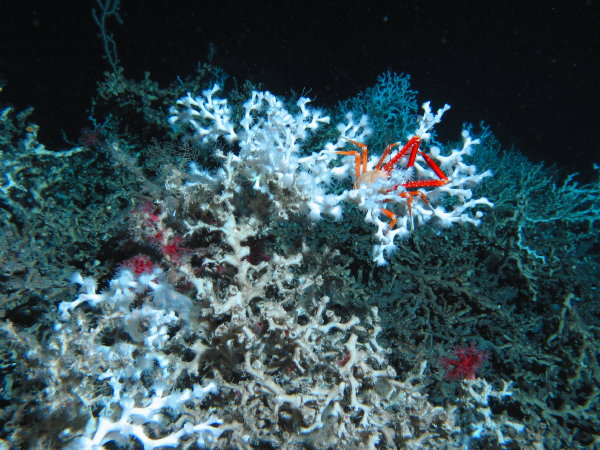DEEP-SEA CORALS WIN PROTECTION IN THE GULF OF MEXICO
by Lynda F. Rysavy | Thursday, Oct 29, 2020
Gulf of Mexico deep-sea corals will soon be protected as part of a first-of-its-kind plan to safeguard some of the region's important coral hotspots and restrict damaging fishing gear in most of the areas.
The Gulf of Mexico Fishery Management Council, which governs fishing in the Gulf's federal waters, unanimously approved the measure at its meeting in Key West, Fla, on June 21.
The rule protects 21 coral
sites, totaling 484 square miles, and restricts damaging fishing gear in most of the areas.
Deep-sea corals are fragile, slow-growing, and can live for thousands of years. Coral ecosystems provide food, shelter, and breeding grounds for wildlife ranging from sharks and crabs to fish such as snapper and grouper.
Florida Atlantic University's Harbor Branch Oceanographic Institute scientists were instrumental in the discovery and proposals for most of the deep coral sites off the west Florida shelf. Professor John Reed and Biological Scientist Stephanie Farrington provided the suggested site protections from their discoveries at the West Florida Wall, Pulley Ridge South, Tortugas South, and Tortugas North Habitat Areas of Particular Concern (HAPCs).
In 2003, FAU Harbor Branch's Division of Biomedical Marine Research made the first discoveries of deep-water coral reefs off the west Florida shelf at depths of 500 m off Tampa.
In 2010 during the Gulf of Mexico oil spill, FAU Harbor Branch's Cooperative Institute of Ocean Research, Exploration and Technology (CIOERT) discovered additional deep-water coral reefs with the
Johnson-Sea-Link
submersible all along the west Florida shelf. During the four years (2012- 2015) Research Professor Dennis Hanisak, Ph.D., Reed and Farrington documented mesophotic coral reef habitat (50- 90 m depths) at Pulley Ridge and Tortugas. These discoveries resulted in doubling the area of the Pulley Ridge HAPC west of the Tortugas. CIOERT Executive Director and Research Professor Joshua Voss, Ph.D., in collaboration with the Flower Gardens National Marine Sanctuary, documented other deep-water coral banks off the Texas coast to be protected.
The new protections mark a major milestone in the effort to safeguard these vital marine environments. The plan
won initial approval
in June 2018 from the Gulf of Mexico Fishery Management Council. More than 11,000 people signed their names in support during a final public comment period in fall 2019.
The plan was several years in the making. Scientists, fishermen, policymakers, and conservationists worked to identify the priority sites and set boundaries that would protect the most corals while allowing fishermen to access productive fishing grounds nearby.